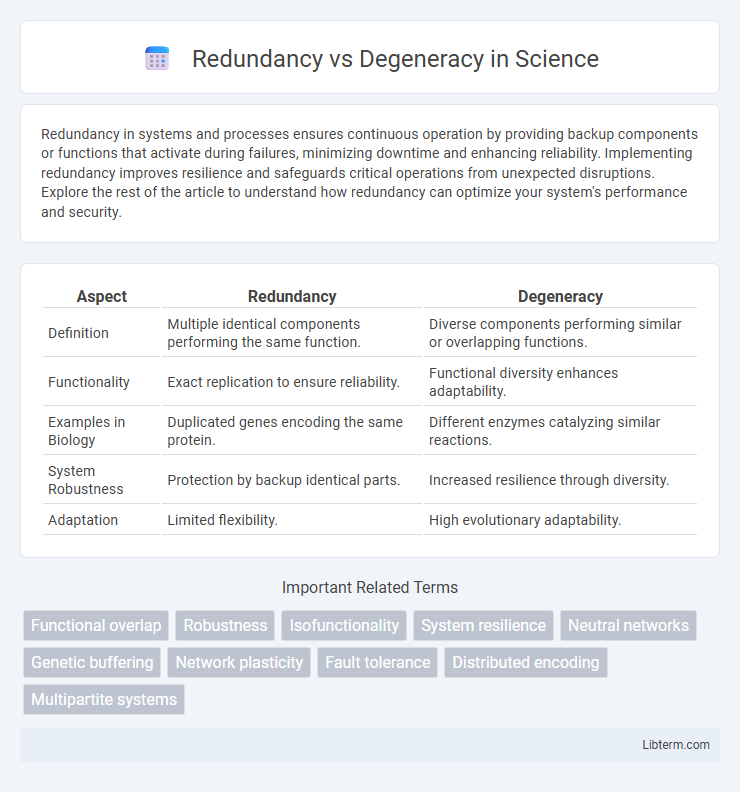Redundancy in systems and processes ensures continuous operation by providing backup components or functions that activate during failures, minimizing downtime and enhancing reliability. Implementing redundancy improves resilience and safeguards critical operations from unexpected disruptions. Explore the rest of the article to understand how redundancy can optimize your system's performance and security.
Table of Comparison
| Aspect | Redundancy | Degeneracy |
|---|---|---|
| Definition | Multiple identical components performing the same function. | Diverse components performing similar or overlapping functions. |
| Functionality | Exact replication to ensure reliability. | Functional diversity enhances adaptability. |
| Examples in Biology | Duplicated genes encoding the same protein. | Different enzymes catalyzing similar reactions. |
| System Robustness | Protection by backup identical parts. | Increased resilience through diversity. |
| Adaptation | Limited flexibility. | High evolutionary adaptability. |
Introduction to Redundancy and Degeneracy
Redundancy refers to the repetition of identical components or information within a system, enhancing reliability and fault tolerance by providing backup elements. Degeneracy involves structurally different components or pathways that perform similar functions, contributing to adaptability and robustness in complex systems. Understanding these concepts is crucial in fields like biology, engineering, and computing for designing resilient systems.
Defining Redundancy in Systems
Redundancy in systems refers to the deliberate duplication of critical components or functions to ensure reliability and prevent failure. This concept involves having multiple identical elements performing the same task, allowing the system to continue operating even if one component fails. Redundancy enhances system robustness by providing backup resources that can take over without impacting overall performance.
Understanding Degeneracy: An Overview
Degeneracy in biological and complex systems refers to the ability of structurally different elements to perform similar functions, enhancing robustness and adaptability. Unlike redundancy, which involves duplicate components with identical roles, degeneracy allows diverse pathways or processes to compensate for one another, providing functional overlap without exact replication. This characteristic is critical for resilience in neural networks, genetic systems, and ecological interactions, enabling flexibility under varying conditions.
Key Differences Between Redundancy and Degeneracy
Redundancy in biological systems refers to the presence of identical components performing the same function, ensuring system reliability through duplication, while degeneracy involves structurally different elements capable of performing similar functions under varying conditions. Redundancy provides robustness by backup functionality, whereas degeneracy offers flexibility and adaptability in response to environmental changes. Understanding these distinctions is crucial in fields like genetics, neural networks, and evolutionary biology, where system resilience and functional variability are essential.
Functional Roles in Biological Systems
Redundancy in biological systems refers to multiple identical elements performing the same function, ensuring robustness through backup mechanisms, as seen in gene families with duplicated genes. Degeneracy describes structurally different elements capable of performing similar functions, contributing to adaptability and resilience by allowing functional compensation under varying conditions, evident in neural circuits and protein networks. Both redundancy and degeneracy enhance system reliability, but degeneracy uniquely supports evolutionary innovation and flexible response to environmental changes.
Redundancy vs Degeneracy in Engineering
Redundancy in engineering refers to the inclusion of extra components or systems designed to take over in case of failure, ensuring reliability and fault tolerance. Degeneracy, on the other hand, involves structurally different elements capable of performing similar functions, enhancing system adaptability and robustness under varying conditions. While redundancy duplicates identical subsystems, degeneracy leverages diverse mechanisms to maintain operational continuity and optimize performance in complex engineering designs.
Impact on System Robustness and Flexibility
Redundancy enhances system robustness by providing multiple identical components that ensure continuous function despite individual failures, while degeneracy contributes to both robustness and flexibility through diverse elements capable of performing overlapping functions under varying conditions. Systems with high degeneracy adapt more effectively to environmental changes, as structurally different components compensate for one another, promoting resilience and functional versatility. The interplay between redundancy and degeneracy thus strengthens system stability, enabling consistent performance and adaptive responses to unforeseen disruptions.
Applications in Artificial Intelligence and Computing
Redundancy in artificial intelligence involves duplicating components or data to enhance system reliability and fault tolerance, particularly in neural networks and error-correcting codes. Degeneracy refers to different components performing similar functions under varying conditions, enabling adaptive and flexible problem-solving in machine learning models and autonomous systems. Leveraging both redundancy and degeneracy improves robustness, efficiency, and resilience in AI algorithms and computing architectures.
Advantages and Disadvantages of Each Concept
Redundancy offers reliability by duplicating identical components, ensuring system functionality when parts fail, but it can lead to increased costs and inefficiency due to resource duplication. Degeneracy provides flexibility and adaptability by allowing different elements to perform similar functions under varying conditions, enhancing robustness in complex systems, though it may complicate system design and control. Both approaches improve resilience, with redundancy favoring straightforward backup strategies and degeneracy enabling dynamic responses to diverse challenges.
Conclusion: Choosing Between Redundancy and Degeneracy
Choosing between redundancy and degeneracy depends on system goals such as robustness, flexibility, and efficiency. Redundancy provides reliability through duplication, ideal for fault tolerance, while degeneracy offers adaptive capacity by enabling components to perform multiple functions under varying conditions. Systems designed for dynamic environments benefit more from degeneracy, whereas static systems prioritize redundancy for predictable performance.
Redundancy Infographic

 libterm.com
libterm.com